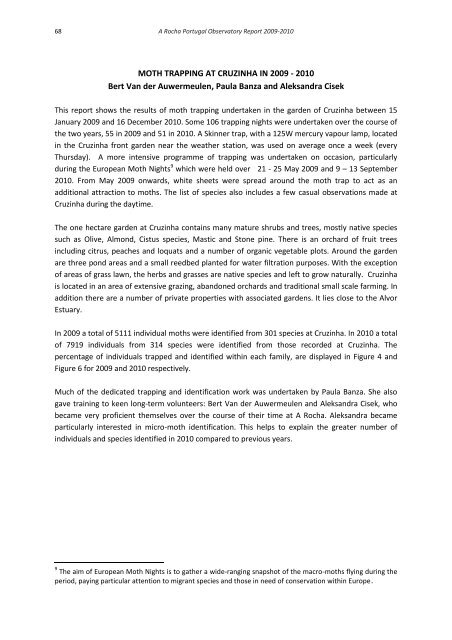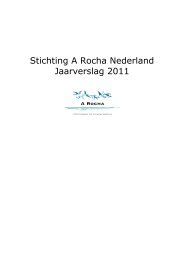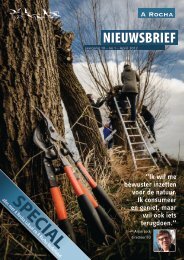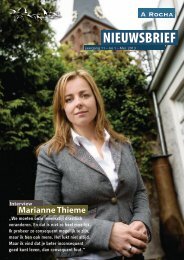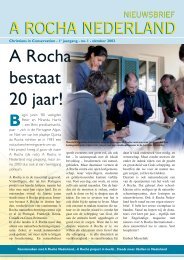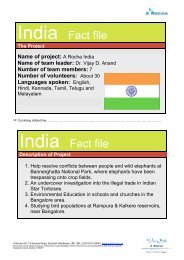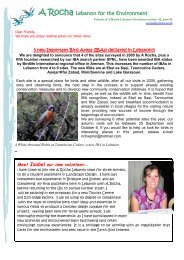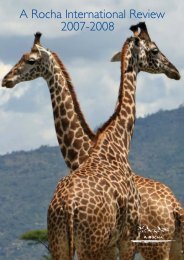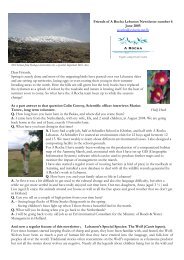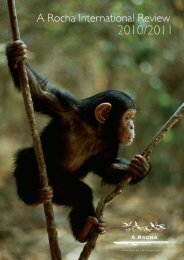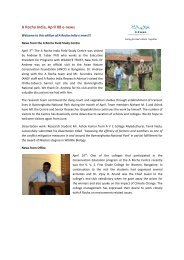A Rocha Portugal Observatory Report 2009-2010
A Rocha Portugal Observatory Report 2009-2010
A Rocha Portugal Observatory Report 2009-2010
You also want an ePaper? Increase the reach of your titles
YUMPU automatically turns print PDFs into web optimized ePapers that Google loves.
68 A <strong>Rocha</strong> <strong>Portugal</strong> <strong>Observatory</strong> <strong>Report</strong> <strong>2009</strong>-<strong>2010</strong><br />
MOTH TRAPPING AT CRUZINHA IN <strong>2009</strong> - <strong>2010</strong><br />
Bert Van der Auwermeulen, Paula Banza and Aleksandra Cisek<br />
This report shows the results of moth trapping undertaken in the garden of Cruzinha between 15<br />
January <strong>2009</strong> and 16 December <strong>2010</strong>. Some 106 trapping nights were undertaken over the course of<br />
the two years, 55 in <strong>2009</strong> and 51 in <strong>2010</strong>. A Skinner trap, with a 125W mercury vapour lamp, located<br />
in the Cruzinha front garden near the weather station, was used on average once a week (every<br />
Thursday). A more intensive programme of trapping was undertaken on occasion, particularly<br />
during the European Moth Nights 9 which were held over 21 - 25 May <strong>2009</strong> and 9 – 13 September<br />
<strong>2010</strong>. From May <strong>2009</strong> onwards, white sheets were spread around the moth trap to act as an<br />
additional attraction to moths. The list of species also includes a few casual observations made at<br />
Cruzinha during the daytime.<br />
The one hectare garden at Cruzinha contains many mature shrubs and trees, mostly native species<br />
such as Olive, Almond, Cistus species, Mastic and Stone pine. There is an orchard of fruit trees<br />
including citrus, peaches and loquats and a number of organic vegetable plots. Around the garden<br />
are three pond areas and a small reedbed planted for water filtration purposes. With the exception<br />
of areas of grass lawn, the herbs and grasses are native species and left to grow naturally. Cruzinha<br />
is located in an area of extensive grazing, abandoned orchards and traditional small scale farming. In<br />
addition there are a number of private properties with associated gardens. It lies close to the Alvor<br />
Estuary.<br />
In <strong>2009</strong> a total of 5111 individual moths were identified from 301 species at Cruzinha. In <strong>2010</strong> a total<br />
of 7919 individuals from 314 species were identified from those recorded at Cruzinha. The<br />
percentage of individuals trapped and identified within each family, are displayed in Figure 4 and<br />
Figure 6 for <strong>2009</strong> and <strong>2010</strong> respectively.<br />
Much of the dedicated trapping and identification work was undertaken by Paula Banza. She also<br />
gave training to keen long-term volunteers: Bert Van der Auwermeulen and Aleksandra Cisek, who<br />
became very proficient themselves over the course of their time at A <strong>Rocha</strong>. Aleksandra became<br />
particularly interested in micro-moth identification. This helps to explain the greater number of<br />
individuals and species identified in <strong>2010</strong> compared to previous years.<br />
9 The aim of European Moth Nights is to gather a wide-ranging snapshot of the macro-moths flying during the<br />
period, paying particular attention to migrant species and those in need of conservation within Europe.


